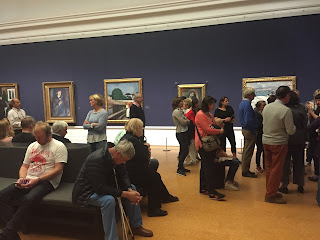Weaving
 |
| Preparing the warp on a four-shaft Saori loom. |
 |
| The B&W-white striped arrangement of the warp. |
 |
| Detail of a recent scarf. |
Floor looms are capable of larger, more intricately patterned work. I've had two opportunities to get a loom of that size, but I'm not ready. I only weave two hours a week, for starts, and I like weaving in a studio with other people. Then there's the question of what do with the output. Early in the summer, I had coffee with an artist friend and traded her a scarf for a painting. I liked that arrangement.
 |
| A scarf drying after being washed. |
 |
| A scarf in a twill pattern. |
 |
| Another view of the scarf I traded. |


Comments
Post a Comment